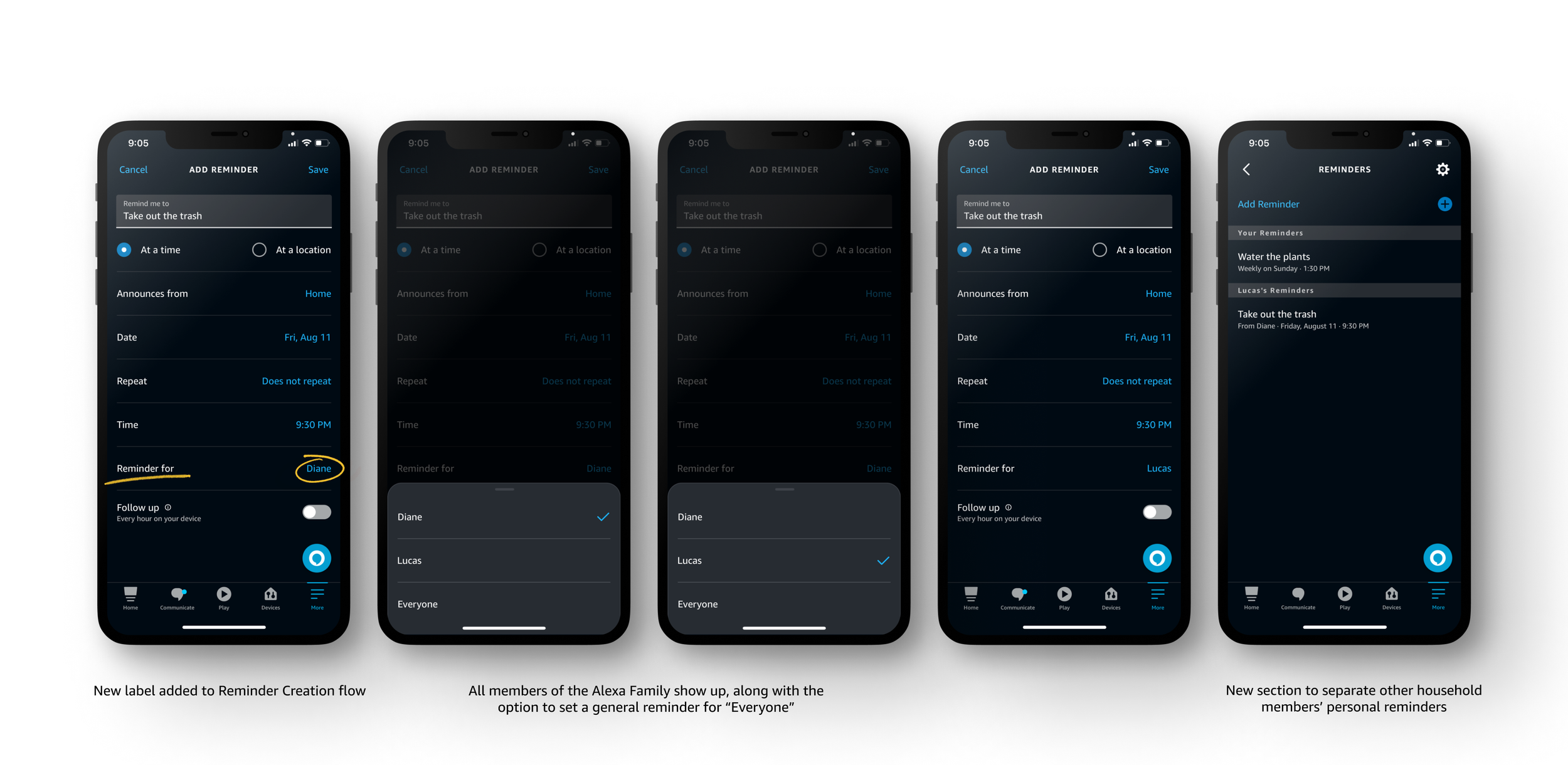Alexa Reminder Assignment
Assigning reminders by name or relationship
Date
February - May 2019
What I did
Conversation design, interaction design, user research
Background
At Amazon, one of the products I worked on was Alexa Reminders. Reminders are one of the most-used and retentive Alexa features, so we were continuously working to find new ways to enhance the experience to align with how people actually organize their life.
Problem
…but “sister” is nowhere to be found, the reminder is “missed” 😓
Since many Alexa devices are utilized as communal household devices rather than personal, we were learning through research and usage data that many of our users set reminders to organize and delegate tasks to others around the household. However, Alexa’s Reminder functionality did not support these multi-user scenarios. Additionally, some users were finding that their reminders would get lost or dismissed by others who are in the room when the reminder goes off, leading to the original user who set the task as “missing” their reminder.

Project Goal
Allow users to have both general reminders (for everyone) and personal reminders that can be assigned to one another by name or relationship.
Research Plan
At the time of this project, our team was short on researchers, so I volunteered to organize and run my own study with UserTesting.com to conduct remote, unmoderated interviews.
I recruited 24 participants with the following criteria:
Use a digital voice assistant (Siri, Alexa, Google Assistant, etc)
Live with another person
Work full-time or part-time
Participants were also bucketed into the following segments: “Young and Childfree” (6 participants), “Families with Children” (12 participants), and “Older Adults” (6 participants).
Key Insights
When tasks don’t get completed as they should, it can be a source of tension in personal relationships
Participants expressed excitement about a digital assistant that could assign reminders, because then the assistant would be an accountability tool, instead of one person having to constantly remind everyone
Many of the participants expected the reminder to go to their partner’s (or whoever they want to remind) phone, either as a notification or text message.
Voice Utterance Data
Participants were asked to imagine they need to assign a task to another household member, and to say the exact phrase they would say to their assistant. The most commonly used phrase and utterance pattern reported was:
“Remind [person A] to do [task] at [time]”
Many participants would also naturally use relationship markers to assign tasks to the people close to them, like “my sister” or “my husband”.
“I’d like that if I was able to assign tasks like that to my husband. And if the reminder could just pop up on his phone, and I wouldn’t have to nag him, that would just be really cool and I never thought of that. That would definitely make my life a lot easier. ”
“This way, nobody can say, ‘oh, nobody reminded me to do the dishes.’ because the digital assistant serves as a reminder. ”
Overall Interaction Design
If the name picked up in the utterance maps to a user in their shared Alexa Family, then that is now a Personal reminder that belongs to that user
If a user has a Voice ID profile set up, Alexa knows who is speaking, so saying “remind me” becomes a “personal” reminder
When the reminder goes off, Alexa will then address the person by name, before reading the reminder, and send a push notification to their phone
NLU and Voice UX
The previous structure of the CREATE_REMINDER intent was only looking at slots for the reminder content and date-time, so the biggest NLU change I was proposing was to add a new slot to detect a name or relation entity. When setting up your Alexa Family members, you can specify your relationship with that member (e.g. “mother”, “husband”, “cousin”) , so that users can speak naturally about those closest to them.
I also rewrote some of Alexa’s prompts to further differentiate when a reminder is “personal”:
Visual UX
In addition to the voice interactions, this feature would also need to be adapted to the Reminder creation flow in the Alexa App, as well as on screened Alexa devices like Echo Show.







